Withdrawing U.S. forces, security assistance, economic aid, and diplomatic engagement from Syria risks allowing the civil war there to continue—or worse, to expand, write Pavel Baev, Ryan Crocker, and Michael O’Hanlon. Meanwhile, ongoing anger and resentment could give rise to ISIS 2.0. This piece originally appeared in USA Today.
American and international strategy towards the horrific conflict in Syria is at a crossroads. ISIS has been largely defeated militarily on the physical battlefield. The top goal of both President Obama and President Trump has been partially achieved, through a strategy they both helped develop and implement. The temptation for Americans in general, and the Trump administration specifically, may be to declare victory and go home—as in fact Trump has just signaled he would like to do, as soon as possible.
That would not be a good idea. Trump deserves credit for his success in Syria, but it represents an interim goal, not a durable achievement. Withdrawing U.S. forces, security assistance, economic aid and diplomatic engagement risks allowing a war that has killed half a million and displaced 12 million to continue—or worse, to expand into a truly regional war. It means that 5 million refugees would remain abroad, continuing to place enormous strains on Turkey, Jordan and Lebanon in particular. It also means that pockets of terrorists would remain intact in several parts of the country, and that Washington would be poorly positioned to manage intensifying Israeli anxieties about Iran’s long-range plans in Syria. Meanwhile, Syria would lie in waste, with many of its communities destroyed beyond functionality. That would produce ongoing anger and resentment among the country’s majority Sunnis in particular, conditions that could give rise to ISIS 2.0. A premature American withdrawal would also concede and condemn even more of the country back to the murderous President Bashar al-Assad and his Iranian allies. Our allies who fought to defeat ISIS on the ground could suffer severe retaliation as their positions were overrun.
Fortunately, there is hope. As bad and fraught as things are, the international community also has some assets and advantages in Syria. Collectively they do provide raw materials out of which a plausible strategy can be built. It will never be able to turn the Syrian war into an outright success; far too much suffering has happened for far too long to make anything we might want to call victory attainable. But for the more modest goals of protecting our surviving allies, stabilizing the country over time, and continuing to weaken extremist groups on Syrian territory, there is hope, if the Trump administration is prepared to develop and apply a serious overall strategy for the Syrian war.
In a January speech at Stanford, former Secretary of State Tillerson outlined elements of such a broader strategy. He is now out of the administration, but the recent Congressional testimony of General Joseph Votel of Central Command reiterated many of these points, as have numerous statements by U.S. Ambassador to the United Nations Nikki Haley. Specifically, Tillerson promised to sustain the military campaigns against ISIS and al Qaeda affiliates, to continue the U.N.-sponsored process in Geneva that aims to produce a new government for the country, to diminish Iran’s influence in Syria, to help refugees and other displaced go home, and to ensure that Syria is free of weapons of mass destruction.
As we have written elsewhere, “to achieve these goals, Tillerson also promised a continued U.S. role to help stabilize that part of the country that Assad does not actually control, while also vowing not to help Assad rebuild any of the parts of the country that the brutal dictator does still control. He pledged that America would respect Turkey’s concerns about Kurdish autonomy and Kurdish terrorist groups. He further promised to expand the use of local ceasefires in Syria to lessen human suffering.”
“There is much to work with in this plan. But some of the goals are unrealistic and require rethinking. First, we need to redefine the U.N. process in Geneva that seeks to create a government of national unity to replace Assad. (Russia’s Astana process is no better.) The UN will not be able to negotiate Assad out of power in favor of a democratic, representative government. We are kidding ourselves, and wasting time, to pretend otherwise. For Assad, this would amount to snatching defeat from the jaws of something that for him approximates victory. Since he comes from the Alawite minority group in Syria, any national government based on majority rule (whether chosen through negotiations or elections) will almost surely displace his closest allies and raise the risks of retaliation against them.” Assad should go from office; the international community cannot live indefinitely, or do business normally, with a mass murderer in the president’s office in Damascus. But we must also accept that he will insist upon having a major hand in choosing his successor through a managed transition. Russia may help us manage a transition but it will almost surely not seek to push Assad from power; after all, Moscow intervened precisely to prop him up and feels vindicated by its overall approach. The Geneva talks should focus for now less on political transition, and more on technical issues like providing relief and reviving agriculture.
Second, most of the other goals, such as helping refugees return and protecting civilians, will take time and only prove possible as we find a way to wind down the fighting. And it is important to underscore that diminishing Iran’s influence will take quite a while, since it requires a rebuilding of the Syrian army under a viable successor government to Assad’s. Only then will Damascus have the means to send Iran’s militias home; until then, our main goal should be to deter attacks by those militias against our forces and those of our allies. In the short term, preventing Iran’s influence from expanding is a more realistic, and crucial, objective than weakening that influence. By helping our local allies stabilize and solidify their areas of current control, we can help achieve that aim.
The realistic path forward is therefore to help our allies in the country’s north, east and south rebuild their infrastructure and restart their economies, while also creating local policing forces but not mobile units that could threaten Assad. We need to keep our current 2,000 forces on the ground to help in this process, while also sustaining the forward air controllers and trainers needed to prevent these local allies from being overrun. Any attacks against U.S. forces should be met with retaliatory blows against Iran’s forces in Syria and perhaps even within Iran itself.
Economics, married to a realistic political strategy for dealing with Assad, may be our strongest suit in this situation. Although Assad’s current allies, Russia and Iran, do have some resources, most of the $100 billion or so in financing that the country will ultimately need to rebuild can only be found from U.S. friends and allies. That money provides a certain amount of leverage—not enough to push Assad literally out of power, but perhaps enough to coax him into forming a successor government with broader representation, and to persuade Moscow to help us in the effort. Western funds should NOT flow to Assad or the regions he controls until he steps down. The only exception would be limited amounts of food and medicine for humanitarian purposes, once he starts respecting ceasefires.
Finally, to pursue a strategy built largely around helping autonomous zones rule themselves (at least temporarily), we need a better answer to the Kurdish question that addresses Turkey’s security concerns while also preventing Kurdish positions in Syria’s north from being overrun. In additional to promoting a ceasefire between the Kurdish PKK in Turkey and Ankara, we should condition most aid to Kurds in Syria on a return of the heavier weapons given to them to fight ISIS, once that battle is truly over. Washington should declare that we will never support an independent Kurdish state in Syria (or elsewhere) and that we also oppose a single, formal Kurdish autonomous region within Syria. To access aid, Syrian Kurds will also need to allow non-Kurdish towns within their broader areas of control a degree of additional local autonomy.
Even with these improvements in strategy, stabilizing Syria will take many more months; rebuilding the nation’s politics and infrastructure will take years. But our core goals of stability, recovery and safety for Syria’s disenfranchised and displaced, and prevention of the emergence of an ISIS 2.0 or the equivalent are within reach, if we stay engaged. It is time to broaden our Syria strategy beyond the simple defeat of ISIS.
The Brookings Institution is committed to quality, independence, and impact.
We are supported by a diverse array of funders. In line with our values and policies, each Brookings publication represents the sole views of its author(s).











Commentary
How do we prevent ISIS 2.0? Withdrawing from Syria is not the answer
April 7, 2018